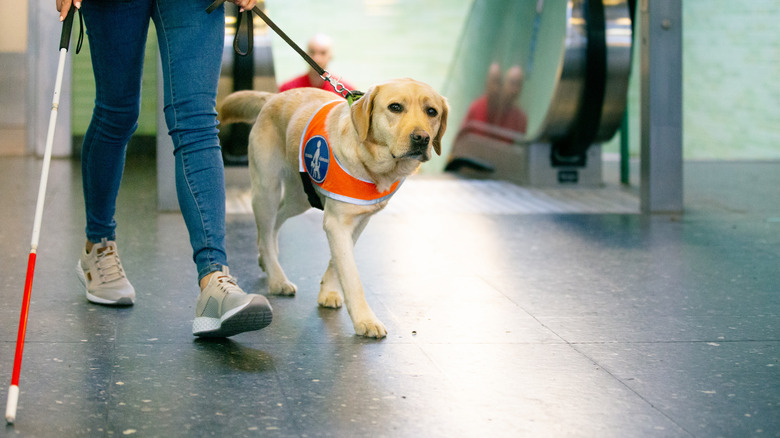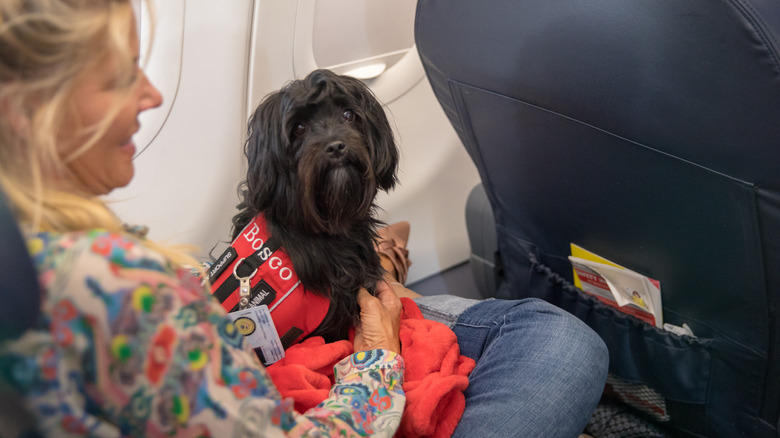What It's Really Like To Go Through A TSA Security Checkpoint With A Service Animal
With an estimated 500,000 service dogs out there currently supporting people in the United States living with disability, there's a growing conversation about how society accommodates these essential animal partners. Beyond being a companion or a pet, service dogs are specially trained to assist their handlers during situations where additional help is needed — allowing them to navigate public spaces safely, with dignity, and with the freedom they deserve.
According to Tiers II and III of the Americans with Disabilities Act (ADA), service dogs are legally allowed to accompany their handler everywhere they go: this includes all types of accommodations and public facilities — even plane travel. From going through airport security to boarding the aircraft, registered service dogs have the right to be by their handler's side at all times. Although the entire process might feel a little daunting, travelers who require a service animal don't need to worry — it's actually extremely streamlined, simple, and comfortable for both the animal and their handler.
In essence, going through TSA with a service dog (or a pet, for that matter) doesn't change much than if you were going through without one. Per the TSA's website, handlers and their animal companion must simply walk through the metal detector — whether together or one after the other — and be prepared to undergo potential additional screening procedures if the machine goes off.
Traveling with a service animal
According to a video posted to YouTube by certified animal trainer, Amber Aquart, the process isn't as difficult as it might seem. In the clip, which details the entire process, Aquart commands her dog to sit-stay while she removes their harness and gear before going through the metal detector. Then, she walks through the machine on her own before commanding her dog to come over. The process itself takes a few seconds — basically the same amount of time as if you weren't traveling with a service dog.
Keep in mind, however, that the TSA does not require that you remove any of your service animal's gear (something that is also noted by Aquart in her video). However, if these accessories set off the alarm, your dog must be put through an additional full-body pat down before you can carry on. If this does happen, you're simply required to stand by your dog, hold its leash, and wait for the agent to complete the inspection. That said, whether or not you remove your dog's gear ultimately depends on what you feel most comfortable with.
As for bringing along any food or medicine for your service dog, it's important to note there are certain items you can't bring through TSA or that require you to adhere to their basic guidelines — wet dog food being one of them. If you do need to travel with wet food, follow the 3-1-1 rule and you should be good. This means the wet food must be in a 3.4-ounce container, but you can bring more than one in your carry-on.
More tips for ensuring a smooth journey
There are certain steps needed to ensure that you and your service animal are well-prepared before it's time to hit the skies. Firstly, the U.S. Department of Transportation (DOT) requires that all travelers fill out and submit a copy of the DOT's Service Animal Transportation Form at least 48 hours before the trip. Along with this, a Service Animal Relief Attestation Form is also required by the DOT. You are not required to pay any additional fees — common for airlines to charge passengers traveling with pets — when traveling with a service dog.
Once at the airport, you can also ask for help if your service animal needs any extra assistance — like a relief station, for example — before boarding the flight. With this in mind, frequent travelers also recommend that you bring along your own clean-up kit in case of emergency, have extra copies of all your documents at hand, and that you keep an eye out for any signs of discomfort or stress coming from your service animal.
Most importantly, though, it's essential to know your rights. It's against the law for airline staff to request any additional documents on top of the two forms mentioned above, or to move you from your seat because of your service animal. Per the ADA's website, the only two additional questions airline staff can legally ask are: "Is the dog a service animal required because of a disability?" and "What work or task has the dog been trained to perform?"

